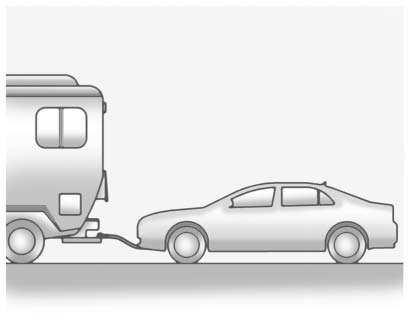Chevrolet Cruze Owners Manual: Recreational Vehicle Towing
Recreational vehicle towing refers to towing the vehicle behind another vehicle – such as behind a motor home. The two most common types of recreational vehicle towing are known as dinghy towing and dolly towing. Dinghy towing is towing the vehicle with all four wheels on the ground. Dolly towing is towing the vehicle with two wheels on the ground and two wheels up on a device known as a dolly.
Here are some important things to consider before recreational vehicle towing: • The towing capacity of the towing vehicle. Be sure to read the tow vehicle manufacturer's recommendations.
• How far the vehicle will be towed. Some vehicles have restrictions on how far and how long they can tow.
• The proper towing equipment.
See your dealer or trailering professional for additional advice and equipment recommendations.
• If the vehicle is ready to be towed. Just as preparing the vehicle for a long trip, make sure the vehicle is prepared to be towed.
Dinghy Towing (With Automatic Transmission)

Notice: If the vehicle is towed with all four wheels on the ground, the drivetrain components could be damaged.
The repairs would not be covered by the vehicle warranty. Do not tow the vehicle with all four wheels on the ground.
Vehicles with an automatic transmission should not be towed with all four wheels on the ground.
If the vehicle must be towed, a dolly should be used. See "Dolly Towing" that follows for more information.
Dinghy Towing (With Manual Transmission)

To dinghy tow the vehicle from the front with all four wheels on the ground: 1. Position the vehicle to tow and then secure it to the towing vehicle.
2. Shift the transmission to Neutral.
3. Turn the ignition to ACC/ ACCESSORY.
4. To prevent the battery from draining while the vehicle is being towed, remove fuse 22, 23, 24, and 25 from the instrument panel fuse block.
Remember to reinstall the fuses once the destination has been reached.
Notice: If 105 km/h (65 mph) is exceeded while towing the vehicle, it could be damaged.
Never exceed 105 km/h (65 mph) while towing the vehicle.

Notice: Towing the vehicle from the rear could damage it. Also, repairs would not be covered by the vehicle warranty. Never have the vehicle towed from the rear.
Dolly Towing

Tow the vehicle with the two rear wheels on the ground and the front wheels on a dolly: To tow the vehicle with two wheels on the ground and a dolly: 1. Put the front wheels on a dolly.
2. Shift the automatic transmission into P (Park) or a manual transmission into 1 (First) gear.
3. Set the parking brake.
4. Clamp the steering wheel in a straight-ahead position with a clamping device designed for towing.
5. Remove the key from the ignition.
6. Secure the vehicle to the dolly.
7. Release the parking brake.

Notice: Towing the vehicle from the rear could damage it. Also, repairs would not be covered by the vehicle warranty. Never have the vehicle towed from the rear.
 Towing the Vehicle
Towing the Vehicle
Notice: Incorrectly towing a disabled vehicle may cause damage. The
damage would not be covered by the vehicle warranty. Do not lash or hook to the
chassis components including the front and rear ...
 Appearance Care
Appearance Care
...
Other materials:
Fuel Additives
To provide cleaner air, all gasolines in the United States are now required to
contain additives that help prevent engine and fuel system deposits from forming,
allowing the emission control system to work properly. In most cases, nothing should
have to be added to the fuel.
However, some gas ...
Engine Coolant
The cooling system in the vehicle is filled with DEX-COOL engine coolant. This
coolant is designed to remain in the vehicle for 5 years or 240 000 km (150,000
mi), whichever occurs first.
The following explains the cooling system and how to check and add coolant when
it is low. If there is a ...
Wheel Stud Replacement
Special Tools
CH-43631 Ball Joint Remover
For equivalent regional tools, refer to Special Tools.
Removal Procedure
Raise and suitably support the vehicle. Refer to Lifting and
Jacking the Vehicle.
Remove the tire and wheel assembly. Refer to Tire and Wheel Removal and
Installati ...
